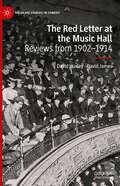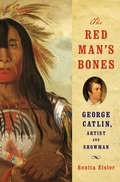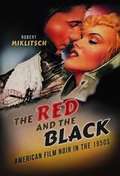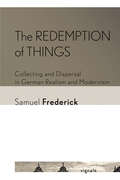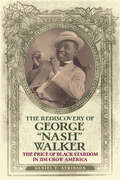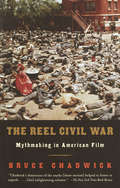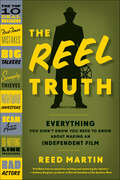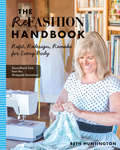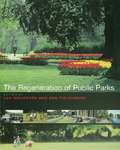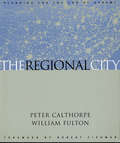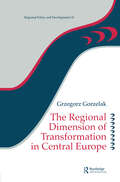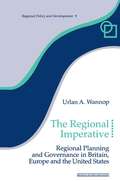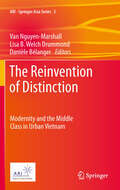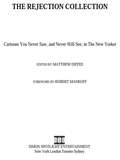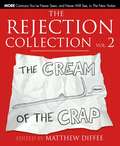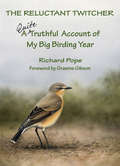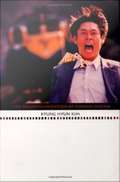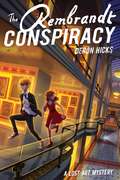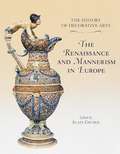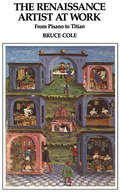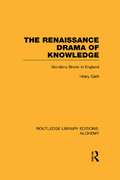- Table View
- List View
The Red Letter at the Music Hall: Reviews from 1902–1914 (Palgrave Studies in Comedy)
by David James David HuxleyThis book reprints and analyses reviews of music hall acts from the family magazine The Red Letter, which was published by the Scottish based firm D C Thomson from 1899 to 1987. The articles under review range in date from 1902 to 1914, covering theatres all over Britain and acts from around the world. The reviews are uniquely detailed and shed light not only on the early acts of comics who would later go on to achieve wider fame, such as Will Hay and Robb Wilton, but also reveal the acts of long forgotten performers. These so-called ‘wines and spirits’ acts—acts that would never top the bill but who nevertheless toured the halls, sometimes for years on end, such as female impersonator Albert Letine, comedy magician Chris van Bern and female stand up Anna Dorothy amongst many others—deserve to be remembered every bit as much as the top of the bill acts. The articles are arranged in sections, covering race, gender, character comedy, physical comedy, male comedy and specialty or ‘spesh’ acts. The reviews reveal not only the contents of the acts but also the audience reactions to those acts and prevailing contemporary Edwardian attitudes. The articles are accompanied by their original illustrations, some of which are unique and, like the articles themselves, unseen for over a century.
The Red Man's Bones: George Catlin, Artist and Showman
by Benita EislerThe first biography in over sixty years of a great American artist whose paintings are more famous than the man who made them. George Catlin has been called the "first artist of the West," as none before him lived among and painted the Native American tribes of the Northern Plains. After a false start as a painter of miniatures, Catlin found his calling: to fix the image of a "vanishing race" before their "extermination"--his word--by a government greedy for their lands. In the first six years of the 1830s, he created over six hundred portraits--unforgettable likenesses of individual chiefs, warriors, braves, squaws, and children belonging to more than thirty tribes living along the upper Missouri River. Political forces thwarted Catlin's ambition to sell what he called his "Indian Gallery" as a national collection, and in 1840 the artist began three decades of self-imposed exile abroad. For a time, his exhibitions and writings made him the most celebrated American expatriate in London and Paris. He was toasted by Queen Victoria and breakfasted with King Louis-Philippe, who created a special gallery in the Louvre to show his pictures. But when he started to tour "live" troupes of Ojibbewa and Iowa, Catlin and his fortunes declined: He changed from artist to showman, and from advocate to exploiter of his native performers. Tragedy and loss engulfed both. This brilliant and humane portrait brings to life George Catlin and his Indian subjects for our own time. An American original, he still personifies the artist as a figure of controversy, torn by conflicting demands of art and success.
The Red and the Black: American Film Noir in the 1950s
by Robert MiklitschCritical wisdom has it that we said a long goodbye to film noir in the 1950s. Robert Miklitsch begs to differ. Pursuing leads down the back streets and alleyways of cultural history, The Red and the Black proposes that the received rise-and-fall narrative about the genre radically undervalues the formal and thematic complexity of '50s noir and the dynamic segue it effected between the spectacular expressionism of '40s noir and early, modernist neo-noir. Mixing scholarship with a fan's devotion to the crooked roads of critique, Miklitsch autopsies marquee films like D.O.A., Niagara, and Kiss Me Deadly plus a number of lesser-known classics. Throughout, he addresses the social and technological factors that dealt deuce after deuce to the genre--its celebrated style threatened by new media and technologies such as TV and 3-D, color and widescreen, its born losers replaced like zombies by All-American heroes, the nation rocked by the red menace and nightmares of nuclear annihilation. But against all odds, the author argues, inventive filmmakers continued to make formally daring and socially compelling pictures that remain surprisingly, startlingly alive. Cutting-edge and entertaining, The Red and the Black reconsiders a lost period in the history of American movies.
The Red and the Blacklist: The Intimate Memoir of a Hollywood Expatriate
by Norma BarzmanThe horrors of the McCarthy era.
The Redemption of Things: Collecting and Dispersal in German Realism and Modernism (Signale: Modern German Letters, Cultures, and Thought)
by Samuel FrederickCollecting is usually understood as an activity that bestows permanence, unity, and meaning on otherwise scattered and ephemeral objects. In The Redemption of Things, Samuel Frederick emphasizes that to collect things, however, always entails displacing, immobilizing, and potentially disfiguring them, too. He argues that the dispersal of objects, seemingly antithetical to the collector's task, is essential to the logic of gathering and preservation. Through analyses of collecting as a dialectical process of preservation and loss, The Redemption of Things illustrates this paradox by focusing on objects that challenge notions of collectability: ephemera, detritus, and trivialities such as moss, junk, paper scraps, dust, scent, and the transitory moment. In meticulous close readings of works by Gotthelf, Stifter, Keller, Rilke, Glauser, and Frisch, and by examining an experimental film by Oskar Fischinger, Frederick reveals how the difficulties posed by these fleeting, fragile, and forsaken objects help to reconceptualize collecting as a poetic activity that makes the world of scattered things uniquely palpable and knowable.
The Rediscovery of George "Nash" Walker: The Price of Black Stardom in Jim Crow America
by Daniel E. AtkinsonThe first biography of George Walker, a uniquely Afro-American tale of innovation and triumph despite the odds; the story of an underdog with a bite!The Rediscovery of George "Nash" Walker is the first biography dedicated to the life and cultural contributions of this actor, writer, and producer who revolutionized Black American theatre during the early twentieth century. In 1892, Walker left his hometown with a medicine show and quickly formed a partnership with comedian Bert Williams that would last nearly eighteen years. Under the moniker of "The Two Real Coons," Williams and Walker used their comedy to erode the stereotyped White image of minstrel-style "cooning." Their theatrical company produced many popular plays, including Clorindy/A Lucky Coon (1899–1900), Policy Players (1900–1901), Sons of Ham (1901–1902), In Dahomey (1902–1905), Abyssinia (1905–1906), Bandanna Land (1907–1909), and Mr. Lode of Koal (1909–1910), even performing on Broadway and abroad. An activist at heart, Walker insisted that audiences receive carefully curated Black entertainment, told from a uniquely Afro-American perspective. Unfortunately, Walker contracted syphilis and was forced to retire in 1909, marking the end of the first golden age of Black theatre. Despite his landmark contributions, Walker's story has been largely forgotten. Drawing on archival resources, newspaper accounts, memoirs, oral histories, and manifestos written by Walker, this book celebrates the accomplishments of the vanguard generation of Black artists who were active between the close of the Civil War and the start of World War I.
The Reel Civil War: Mythmaking in American Film
by Bruce ChadwickArguing that film consistently distorts and sanitizes the past, Chadwick (history and film, Rutgers U.) details the distortions and myths purveyed by film from the KKK to the 1993 film in which actor Richard Gere plays a former slave-owner who is miraculously transformed into a populist who heroically drives off the KKK from a racially integrated community. For the bulk of film's history, myths have portrayed a myth of the underdog Southerner and demeaned African Americans, but new "politically correct," yet still sanitized, versions have begun to crop up in Hollywood productions. In the end, Chadwick seems to believe, despite changes in the treatment of the Civil war on screen, the "reel" still fails to be "real." Annotation c. Book News, Inc., Portland, OR (booknews.com)
The Reel Truth: Everything You Didn't Know You Need to Know About Making an Independent Film
by Reed MartinDid you know that most of the biggest indie filmmakers, screenwriters, and producers working today each made the same avoidable mistakes early on in their careers?The Reel Truth details the pitfalls, snares, and roadblocks that aspiring filmmakers encounter. Reed Martin interviewed more than one hundred luminaries from the independent film world to discuss the near misses that almost derailed their first and second films and identify the close shaves that could have cut their careers short. Other books may tell you the best way to make your independent film or online short, but no other book describes so candidly how to spot and avoid such issues and obstacles as equipment problems, shooting-day snafus, postproduction myths, theatrical distribution deal breakers, and dozens of other commonly made missteps, including the top fifty mistakes every filmmaker makes.From personal experience and his years as a freelance reporter covering independent film for USA Today and Filmmaker magazine, Martin uncovers the truth about the risks and potential rewards that go with chasing celluloid glory. Whether you're writing a screenplay, looking for financing, about to start shooting, or thinking about investing time and money (or someone else's money) in an independent film, The Reel Truth is a must-read.
The Refashion Handbook: Refit, Redesign, Remake for Every Body
by Beth HuntingtonTake secondhand finds from frumpy to fabulous with this guide by the Renegade Seamstress featuring resizing techniques and 19 refashioning projects.With her award-winning blog, The Renegade Seamstress, Beth Huntington combines two of her favorite activities—thrifting and sewing—into the art of refashioning. In The Refashion Handbook, she shares 19 stylish projects, each showing you how to transform easy-to-find items into a better fit, a new design, or a radical makeover. Learn the basics of refashioning: how to measure, reshape, fit, and finish a garment, so it fits you perfectly. Plus size? Petite? No problem! Beth's designs flatter a wide variety of sizes and body types. Her easy techniques are perfect for beginners and even experienced sewists will appreciated her clever tips and tricks.
The Reflective Museum Practitioner: Expanding Practice in Science Museums
by Laura W. Martin Lynn Uyen Tran Doris B. AshThe Reflective Museum Practitioner explores a range of expansive and creative ways in which the concept of “reflective practice” has been applied in the informal STEM (science, technology, engineering, and mathematics) learning environments of museums and zoos. It seeks to demonstrate how such a process can inspire lifelong learning in practitioners, to the benefit of practitioners and visitors alike. Presenting six projects that employed reflective practice, the contributors examine how each project has encouraged and sustained reflection, and the outcomes thereof. The projects cover a wide range of different practitioners—including administrators, scientists, educators, and other front-line and back-room staff—who work at different junctures of their organizations. Collectively, they raise key questions about changing communities of practice in Informal Science Learning institutions. The projects and concept of “reflective practice” are fully defined and contextualized by the editors, who offer in-depth analysis, along with a cultural-historical activity theory framework, for understanding how changes in museum practice unfold in an institutional context. The Reflective Museum Practitioner offers museum professionals insight into “reflective practice,” as practiced by other institutions in their sector, providing practical examples that can be adapted to their needs. It will also be of interest to scholars and students focusing on science museums, or professional practice development in museums.
The Regeneration of Public Parks
by Jan Woudstra Ken FieldhouseThe Urban Parks Programme, financed by the Heritage Lottery Fund, has sparked a new enthusiasm for the regeneration of Britain's parks. This unique reference book gives a valuable overview of all the elements of public park design. It emphasizes our parks' diversity and richness, and offers practical guidance as to their renovation and future care. It is essential reading for all those involved in the design, upkeep and regeneration of public parks.
The Regional City: Planning For The End Of Sprawl
by William Fulton Peter CalthorpeMost Americans today do not live in discrete cities and towns, but rather in an aggregation of cities and suburbs that forms one basic economic, multi-cultural, environmental and civic entity. These "regional cities" have the potential to significantly improve the quality of our lives--to provide interconnected and diverse economic centers, transportation choices, and a variety of human-scale communities. In The Regional City, two of the most innovative thinkers in the field of land use planning and design offer a detailed look at this new metropolitan form and explain how regional-scale planning and design can help direct growth wisely and reverse current trends in land use. The authors: *discuss the nature and underpinnings of this new metropolitan form *present their view of the policies and physical design principles required for metropolitan areas to transform themselves into regional cities *document the combination of physical design and social and economic policies that are being used across the country *consider the main factors that are shaping metropolitan regions today, including the maturation of sprawling suburbs and the renewal of urban neighborhoods Featuring full-color graphics and in-depth case studies, The Regional City offers a thorough examination of the concept of regional planning along with examples of successful initiatives from around the country. It will be must reading for planners, architects, landscape architects, local officials, real estate developers, community development professionals, and for students in architecture, urban planning, and policy.
The Regional Dimension of Transformation in Central Europe (Regions and Cities)
by Grzegorz GorzelakProviding a new picture of the socio-economic map of central Europe after several years of transformation, and focusing in particular on Poland, this book gives an account of the major problems of regional restructuring. The author identifies the opportunities and problems faced by particular regions by relating the Polish experience to the experience of other central European countries. This in turn provides a general picture of spatial patterns of transformation in this specific part of Europe and will interest those concerned with the transformation of Eastern Europe.
The Regional Imperative: Regional Planning and Governance in Britain, Europe and the United States (Regions and Cities #Vol. 9)
by Urlan A. WannopBased on cases and interviews in Britain, Europe and the United States, this book explains the recurrence of regional planning and of initiatives in regional governance, in a wide range of advanced industrial countries. Providing an analysis of the nature of regional planning and governance, the book traces the development of regional planning and the institutions associated with it. It also looks at the way that regions have been changing their form under pressure from economic and political developments and examines how regional planning and governance has responded, comparing experience in the UK, the rest of Europe and the US. In concluding that regionalism is an imperative feature of politics in most countries, associated with almost any of the variety of forms of governance, the author offers a major appraisal of the significance of regional planning in an intemational context
The Reinvention of Distinction
by Danièle Bélanger Lisa B. Drummond Van Nguyen-MarshallThis pioneering collection brings together an international group of scholars to explore the Vietnamese middle class. From the leisure pursuits of the colonial middle class to the impact of the new urban rich on landscape of the countryside, this interdisciplinary volume explores the ways in which middle classness has been practiced in a wide range of contexts throughout the 20th century and into the 21st. In addition to offering insights into how middle classness was and is constituted and negotiated, this collection illuminates the cultural and social conditions of two distinctive periods in Vietnamese history. Three historical chapters consider how middle class status was experienced and displayed under French colonialism and in 1960s republican. These chapters offer examinations of middle classness through recreation, consumption, and associational life. Six contemporary studies examine the modes of experimentation and practice within middle class urban Vietnam. Still a sensitive topic politically, the contemporary middle class, nascent but increasingly powerful, is exerting a strong impact on the shape of contemporary society and culture, as well as on urban and rural landscapes. This volume offers a series of studies which critically interrogate the practices of those who engage in or aspire to urban middle-class lifestyles in Vietnam both in the past and in the present.
The Rejection Collection
by Matthew Diffee Robert MankoffEach week about fifty New Yorker cartoonists submit ten ideas, yielding five hundred cartoons for no more than twenty spots in the magazine. Arguably the most brilliant single-panel-gag cartoonists in the world create a bunch of cartoons every week that never see the light of day. These rejects were piling up in the dusty corners of studios all over the country. Sam Gross, who has been contributing since 1962, has more than 12,000 rejected cartoons. (Seriously. He's been numbering every single cartoon he's ever submitted to The New Yorker since the very beginning.) Enter editor Matthew Diffee. He tapped his fellow cartoonists, asking them to rescue these hilarious lost gems. From the artists' stacks of all-time favorite rejects, Diffee handpicked the standouts -- the cream of the crap -- and created The Rejection Collection, a place where good ideas go when they die. Too risqué, silly, or weird for The New Yorker, the cartoons in this book offer something no other collection has: They have never been seen in print until now. With a foreword by New Yorker cartoon editor Robert Mankoff that explains the sound judgment, respectability, and scruples not found anywhere in these pages, and handwritten questionnaires that introduce the quirky character of each artist, The Rejection Collection will appeal to fans of The New Yorker...and to anyone with a slightly sick sense of humor.
The Rejection Collection Vol. 2
by Matthew DiffeeEach week The New Yorker receives more than five hundred submissions from its regular cartoonists, who are all vying for one of the twenty coveted spots in the magazine. So what happens to the 75 percent of cartoons that don't make the cut? Some go back in a drawer, others go up on the refrigerator or into the filing cabinet...but the very best of all the rejects can be found right here in these pages. The Rejection Collection Vol. 2: The Cream of the Crap is the ultimate scrap heap of creative misfires -- from the lowbrow and the dirty to the politically incorrect and the weird, these rejects represent the best of the worst...in the best possible sense of the word. Handpicked by editor Matthew Diffee, these hilarious cartoons are accompanied by handwritten questionnaires and photographed self-portraits, providing a rare glimpse into the minds of the artists behind the rejection. With appendices that explore the top ten reasons why cartoons are rejected and examine the solitary nature of the job of cartooning -- plus a special bonus section of questions asked of and answered by cartoon editor Robert Mankoff -- this sequel to The Rejection Collection offers even deeper insight into the exercise in frustration, patience, and amusement that is being a New Yorker cartoonist. Warped, wicked, and wildly funny, The Rejection Collection Vol. 2 will appeal to every New Yorker fan -- and everyone with a taste for the absurd.
The Reluctant Twitcher: A Quite Truthful Account of My Big Birding Year
by Richard PopeRichard Pope, author of Me n Len: Life in the Haliburton Bush, 1900-1940 and the voyageur epic Superior Illusions, is a recently retired professor of Russian literature and culture at York University and a long-standing member of the Ontario Ornithological Club and the Ontario Field Ornithologists. He and his wife, Felicity, live in Cobourg, Ontario. The human side of birding comes to the fore in The Reluctant Twitcher, a serious yet humorous account of birds and birding and the art of chasing rarities. Richard Pope, a lifelong birder, had successfully avoided this latter pursuit for many years but capitulated in 2007 when he embarked on his "Big Year," the object being to record at least three hundred birds in Ontario within that calendar period. Almost instantly, a relatively normal birdwatcher morphed into a "twitcher," albeit reluctantly, pursuing rare species of birds from Rainy River to the Ottawa and well beyond his wildest expectations. Though it was a challenge that was not without trials and disappointments, Pope describes all his adventures with self-deprecating humour. Not just another book on birding, Pope’s unique approach is supported by an array of exceptional colour photographs.
The Remasculinization of Korean Cinema
by Kyung Hyun KimIn one of the first English-language studies of Korean cinema to date, Kyung Hyun Kim shows how the New Korean Cinema of the past quarter century has used the trope of masculinity to mirror the profound sociopolitical changes in the country. Since 1980, South Korea has transformed from an insular, authoritarian culture into a democratic and cosmopolitan society. The transition has fueled anxiety about male identity, and amid this tension, empowerment has been imagined as remasculinization. Kim argues that the brutality and violence ubiquitous in many Korean films is symptomatic of Korea's on-going quest for modernity and a post-authoritarian identity. Kim offers in-depth examinations of more than a dozen of the most representative films produced in Korea since 1980. In the process, he draws on the theories of Jacques Lacan, Slavoj Zizek, Gilles Deleuze, Rey Chow, and Kaja Silverman to follow the historical trajectory of screen representations of Korean men from self-loathing beings who desire to be controlled to subjects who are not only self-sufficient but also capable of destroying others. He discusses a range of movies from art-house films including To the Starry Island (1993) and The Day a Pig Fell into the Well (1996) to higher-grossing, popular films like Whale Hunting (1984) and Shiri (1999). He considers the work of several Korean auteurs--Park Kwang-su, Jang Sun-woo, and Hong Sang-su. Kim argues that Korean cinema must begin to imagine gender relations that defy the contradictions of sexual repression in order to move beyond such binary struggles as those between the traditional and the modern, or the traumatic and the post-traumatic.
The Rembrandt Conspiracy (The Lost Art Mysteries)
by Deron R. HicksIn this standalone companion to The Van Gogh Deception, Art and Camille team up once again to solve a large museum theft, using one of the biggest heists in history to help them solve the case. Perfect for fans of Dan Brown and the Mr. Lemoncello's Library and Book Scavenger series. Something&’s brewing at the National Portrait Gallery Museum in Washington, D.C. twelve-year-old Art is sure of it. But his only proof that a grand heist is about to take place is iced mocha, forty-two steps, and a mysterious woman who appears like clockwork in the museum. When Art convinces his best friend, Camille, that the heist is real, the two begin a thrilling chase through D.C. to uncover a villainous scheme that could be the biggest heist since the Isabelle Stewart Gardner Museum theft in 1990. With a billion dollars&’ worth of paintings on the line, the clock is ticking for Art and Camille to solve the conspiracy.
The Renaissance
by Walter PaterPater's graceful essays discuss the achievements of Botticelli, Leonardo, Michelangelo, and other artists. Included is his celebrated discussion of the Mona Lisa in a study of Da Vinci. This book concludes with an uncompromising advocacy of hedonism, urging readers to experience life as fully as possible. His cry of "art for art's sake" became the manifesto of the Aesthetic Movement, and his assessments of Renaissance art have influenced generations of readers. Oscar Wilde called this collection of essays the "holy writ of beauty."
The Renaissance And Mannerism In Europe
by John Goodman Alain Gruber Margherita Azzi-Visentini Jacques Thuillier Michele Bimbenet-PrivatThe first volume in a three-volume set devoted to the history of decorative arts from the 15th to the early 20th century. It is a massive, beautifully produced work, translated from the original French edition (1993, Editio-Editions Citadelles & Mazenod, Paris), and covering the period from about 14
The Renaissance Artist At Work: From Pisano To Titian
by Bruce ColeThis book gives the necessary background for the study and appreciation of Italian painting and sculpture from about 1250 to 1550. It tells how the artists learned their craft, the organization of their workshops, and the guilds they belonged to; how their customers or patrons treated them and where their work was displayed?churches, civic buildings, or private homes. The book discusses how art was made?tempera, oil, panel, canvas, fresco; it surveys the characteristic types of Renaissance art?altarpieces, portraits, tombs, busts, doors fountains, medals, etc.
The Renaissance Drama of Knowledge: Giordano Bruno in England (Routledge Library Editions: Alchemy)
by Hilary GattiGiordano Bruno’s visit to Elizabethan England in the 1580s left its imprint on many fields of contemporary culture, ranging from the newly-developing science, the philosophy of knowledge and language, to the extraordinary flowering of Elizabethan poetry and drama. This book explores Bruno's influence on English figures as different as the ninth Earl of Northumberland, Thomas Harriot, Christopher Marlowe and William Shakespeare. Originally published in 1989, it is of interest to students and teachers of history of ideas, cultural history, European drama and renaissance England. Bruno's work had particular power and emphasis in the modern world due to his response to the cultural crisis which had developed - his impulse towards a new ‘faculty of knowing’ had a disruptive effect on existing orthodoxies – religious, scientific, philosophical, and political.
The Renaissance: Studies in Art and Poetry
by Walter Horatio PaterA discussion of Renaissance art and poetry from a 19th-century author with scholarly annotations.
